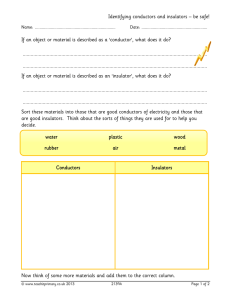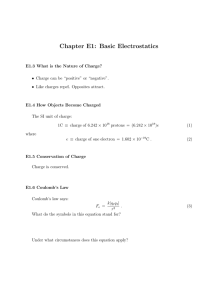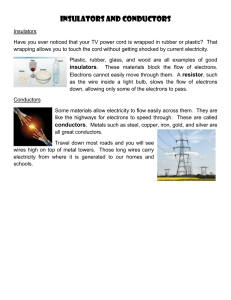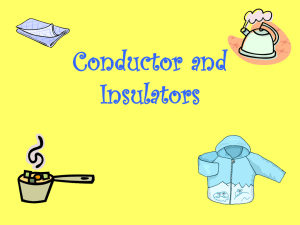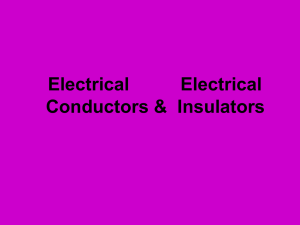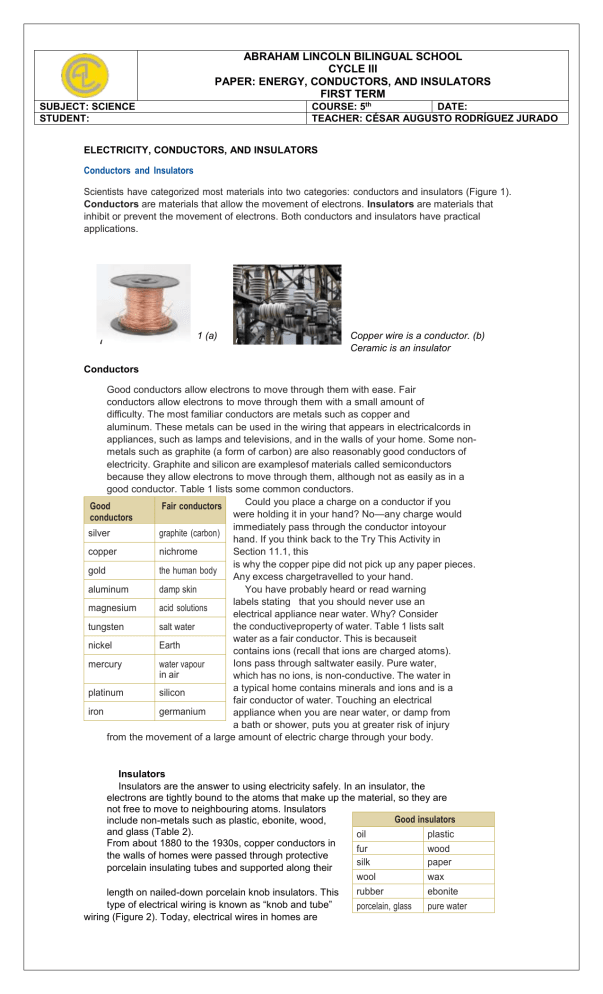
ABRAHAM LINCOLN BILINGUAL SCHOOL CYCLE III PAPER: ENERGY, CONDUCTORS, AND INSULATORS FIRST TERM COURSE: 5th DATE: TEACHER: CÉSAR AUGUSTO RODRÍGUEZ JURADO SUBJECT: SCIENCE STUDENT: ELECTRICITY, CONDUCTORS, AND INSULATORS Conductors and Insulators Scientists have categorized most materials into two categories: conductors and insulators (Figure 1). Conductors are materials that allow the movement of electrons. Insulators are materials that inhibit or prevent the movement of electrons. Both conductors and insulators have practical applications. 1 (a) Copper wire is a conductor. (b) Ceramic is an insulator Conductors Good conductors allow electrons to move through them with ease. Fair conductors allow electrons to move through them with a small amount of difficulty. The most familiar conductors are metals such as copper and aluminum. These metals can be used in the wiring that appears in electricalcords in appliances, such as lamps and televisions, and in the walls of your home. Some nonmetals such as graphite (a form of carbon) are also reasonably good conductors of electricity. Graphite and silicon are examplesof materials called semiconductors because they allow electrons to move through them, although not as easily as in a good conductor. Table 1 lists some common conductors. Could you place a charge on a conductor if you Good Fair conductors were holding it in your hand? No—any charge would conductors immediately pass through the conductor intoyour silver graphite (carbon) hand. If you think back to the Try This Activity in Section 11.1, this copper nichrome is why the copper pipe did not pick up any paper pieces. gold the human body Any excess chargetravelled to your hand. aluminum damp skin You have probably heard or read warning labels stating that you should never use an magnesium acid solutions electrical appliance near water. Why? Consider the conductiveproperty of water. Table 1 lists salt tungsten salt water water as a fair conductor. This is becauseit nickel Earth contains ions (recall that ions are charged atoms). Ions pass through salt water easily. Pure water, mercury water vapour in air which has no ions, is non-conductive. The water in a typical home contains minerals and ions and is a platinum silicon fair conductor of water. Touching an electrical iron germanium appliance when you are near water, or damp from a bath or shower, puts you at greater risk of injury from the movement of a large amount of electric charge through your body. Insulators Insulators are the answer to using electricity safely. In an insulator, the electrons are tightly bound to the atoms that make up the material, so they are not free to move to neighbouring atoms. Insulators Good insulators include non-metals such as plastic, ebonite, wood, and glass (Table 2). oil plastic From about 1880 to the 1930s, copper conductors in fur wood the walls of homes were passed through protective silk paper porcelain insulating tubes and supported along their wool wax rubber ebonite length on nailed-down porcelain knob insulators. This type of electrical wiring is known as “knob and tube” porcelain, glass pure water wiring (Figure 2). Today, electrical wires in homes are ABRAHAM LINCOLN BILINGUAL SCHOOL CYCLE III PAPER: ENERGY, CONDUCTORS, AND INSULATORS FIRST TERM SUBJECT: SCIENCE COURSE: 5th DATE: STUDENT: TEACHER: CÉSAR AUGUSTO RODRÍGUEZ JURADO coated with an insulating material, such as plastic. Electricity distribution also uses insulators. For example, electricity transmission wires are connected to poles using insulating materials (Figure 3). Insulators protect us from the danger of having large amounts of electric charge move through our bodies if we come in contact with a conductor. Placing a plastic insulator around a copper wire prevents electrons from escaping the conductor. In this way, the electrons stay in the conductor and discharges are avoided Using Conductors and Insulators Different types of technology use conducting and insulating materials to work properly. For example, technologies such as lightning rods and automobile frames and bodies are made of conducting materials. Glass has been used as an insulator in telegraph wiring since the 1800s. The telecommunications industry uses teflon and silicon dioxide as electrical insulators to protect against exposed wiring. A laser printer is a common household electrical device that requires the properties of both insulators and conductors. Laser Printers Laser printers use conductors and insulators, as well as the Law of Electric Charges, to work (Figure 4). A laser printer consists of a drum made of a positively charged photoconductor. A photoconductor is a special class of conductor that conducts electrons only when a light shines on it. If no light shines on it, it remains an insulator Figure 4 Laser printers use conductors and insulators to produce images. In this case, the light is a laser. The laser light quickly “draws” the image to be printed across a positively charged selenium drum, causing these areas to become negatively charged. The drum is then rolled across positively charged toner particles that are attracted to the negatively charged areas on the drum and are repelled by the positive areas (Figure 5(b)). When the drum is rolled over paper that has been given a larger negative charge than the drum, the positive toner particles become attracted to the negative paper (Figure 5(c)). The paper then passes through a fuser that melts the toner particles, which are made from plastic, onto the paper using temperatures of over 200 °C. The paper does not catch fire because of how quickly this process happens. There is also a fan that keeps the area around the fuser cool.



